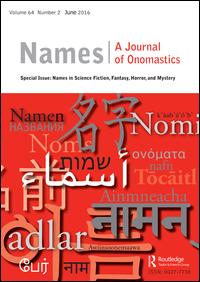Published 2014-03-01
Keywords
- Convincing Ground,
- polysemy,
- onomastic palimpsest,
- historiography,
- whaling
- Aboriginal massacre site ...More
Copyright (c) 2014 Maney Publishing

This work is licensed under a Creative Commons Attribution 4.0 International License.
Abstract
AbstractMost first names are exclusively popular for females or males. A minority of first names are unisex, defined as being given with substantial frequency to both genders in the same population in the same year. First-name frequencies for births in Pennsylvania in 1990, 1995, 2000, 2005, and 2010 provided information on babies given unisex names. Children of a White mother were compared with children of a Black mother. The unisex names were divided into two types of gender preference or consistency, from 1990 to 2010. Change usually was from a small majority of males to a large majority of females. Consistency generally was a preference for males. Females more often than males therefore were given a name that was consistently more popular for the opposite gender. Great diversity of names given in Pennsylvania contributed to the occurrence of unisex names.
References
- Barry, Herbert, III, and Harper Aylene S.. 1982. “Evolution of Unisex Names.” Names 30: 15–22.
- Barry, Herbert, III, and Harper Aylene S.. 1993. “Feminization of Unisex Names.” Names 4: 228–238.
- Barry, Herbert, III, and Harper Aylene S.. 2010. “Racial and Gender Differences in Diversity of First Names.” Names 58: 47–54.
- Barry, Herbert, III, and Harper Aylene S.. 2013. “National Differences in Personality and Predictability of Gender from Personal Names.” Cross-Cultural Research 47: 363–371.
- Lieberson, Stanley, and Mikelson. Kelly S. 1995. “Distinctive African American Names: An Experimental, Historical, and Linguistic Analysis of Innovation.” American Sociological Review 60: 928–946.
- Lieberson, Stanley, Susan Dumais, and Shyron Baumann. 2000. “The Instability of Androgynous Names: The Symbolic Maintenance of Gender Boundaries.” American Journal of Sociology 105: 1249–1287.
- Norusis, Marija J. 2009. PASW Statistics 18 Statistical Procedures Companion. Upper Saddle River, New Jersey: Prentice Hall.
- Pennsylvania. 1992. Pennsylvania Vital Statistics Annual Report, 1990. Harrisburg: Pennsylvania State Health Data Center.
- Tucker, D. Kenneth. 2009. “Increased Competition and Reduced Popularity: US Given Name Trends of the Twentieth and Early Twenty-First Centuries.” Names 57: 52–62.

